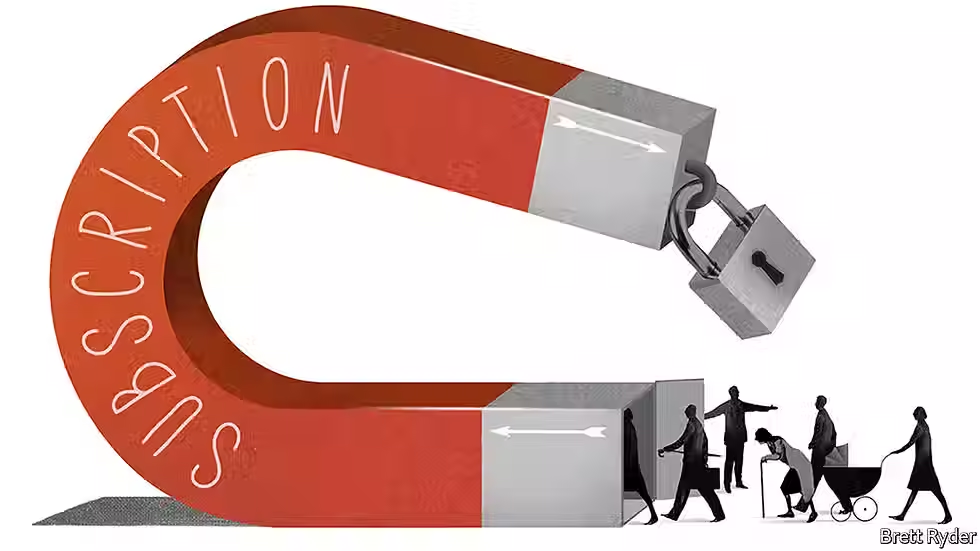The Rise of the 'Subscription Economy'
- Krishiv Jaiswal
- Jul 18, 2024
- 4 min read
Digital services have become a more integral component of our lives, regardless of whether they are incorporated with the things we are familiar with today. People have evolved. They are seeking novel ways to interact with businesses; accessing products in a more versatile and extensible way. Modern customers have a fresh set of requirements. They want the freedom to decide where, how much, and how they pay for their consumption. They are less interested in owning things, rather than accessing them. They desire perpetual enhancement, not antiquity. Personalisation, not generalisation. Responsiveness, not perfection.
The outcome? The manner which businesses market their goods and services is shifting. Every sector is changing to subscription business models, which have tapped into this trend by offering users the convenience of accessing products and services without the hassle of ownership. Consider Netflix, Amazon Prime, Uber, and Spotify as examples of the influx of these new business models that have emerged in the last few years, all of which are intended to keep users engaged continually in long-term relationships. In addition to these streaming and delivery services, there are clothing, stationery, and sports accessories adapting to this change. Nowadays, some people have no fewer than ten products signed up for.
The ‘Subscription Economy’ introduces the broad trend of businesses switching from the conventional pay-per-product approach to a subscription revenue approach. This economy entails offering consumers recurrent subscriptions in return for ongoing access to a good or service, as opposed to traditional casual buying. Former economies leaned solely on gaining new clients, delivering products, and charging for one-off transactions. But in this new era of companies, relationships are everything. Subscription experiences built around services better meet consumers' needs than static options or one specific good, and that is why a greater proportion of customers are turning to subscription models. Suddenly, exploiting long-term relationships rather than providing items haywire has become a prerequisite to success. These market trends are affecting all industries, with consumer tastes growing more sophisticatedly and businesses starting to realise that if they don't meet their demands, one of their competitors will. In multiple sectors, the subscription economy model has already supplanted transactional business models, where systems were set up to make, sell, maintain stock, ship out, and earn money for a product.

Apart from the shift in the attitude of consumers, the coronavirus pandemic has also prompted a surge in subscriptions as people, who were essentially in ‘shutdown’ mode, turned to digital entertainment and signed up for regular home delivery of boxes containing goods such as toiletries and clothing. However, the rise in subscribers in the severely impacted services sector was what really made the model stand out. Restaurants, hotels, home-repair firms, and other business owners who experimented with subscriptions discovered deeper interest and revenue than they originally expected. Another factor contributing to the growth of the subscription economy is the advancement of technology. With the rise of cloud-based computing and the proliferation of mobile devices, companies can offer subscription-based services that are accessible from anywhere, at any time. This has enabled businesses to offer a more personalised and seamless experience to users, which has resulted in increased loyalty and retention.
The subscription economy has also given rise to new business opportunities. Subscription-based businesses have lower customer acquisition costs than long-established businesses, as they rely on recurring revenue from existing customers. This has enabled small businesses to compete with larger, established companies by offering niche products and services to a dedicated customer base. In addition, the subscription model has allowed businesses to experiment with new products and services without the risk of heavy upfront investment.
However, the economy is facing a wide spectrum of barriers as a result of subscriptions' meteoric expansion, far outpacing the government's capacity to regulate intrusive marketing tactics and guarantee that customers are accommodated with equal regard. One of the main challenges for businesses is to maintain customer satisfaction and retention. As subscription-based services become more commonplace, consumers have become more discerning about the value they receive from their subscriptions. Companies must constantly innovate and improve their offerings to keep customers engaged and prevent them from churning. Another challenge is the need to manage cash flow. Subscription-based businesses must rely on regular, recurring revenue to sustain their operations. This requires careful financial planning and management to ensure that the business remains profitable and sustainable. Despite these challenges, the subscription economy shows no signs of slowing down. The subscription e-commerce market has grown exponentially each year. This trend is expected to continue, with subscription-based services becoming the norm across various industries.
All in all, the ‘Subscription Economy’ enables a much higher level of customer engagement, with greater certainty and stability in business transactions. There’s no denying that a consumer's sense of intimacy, and goodwill, under this business strategy, are dubious. Having said that, delivering multi-channel experiences and services, all while coming up with new ways to provide ongoing value to your clients that will foster loyalty over time is what makes subscription-based firms thrive or perish. As the subscription economy continues to grow, it will be interesting to see how businesses adapt and innovate to meet the unfolding needs of consumers.





